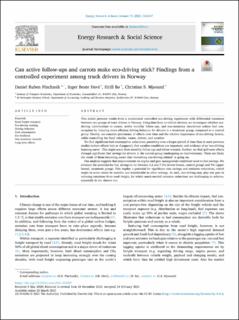| dc.contributor.author | Pinchasik, Daniel Ruben | |
| dc.contributor.author | Hovi, Inger Beate | |
| dc.contributor.author | Bø, Eirill | |
| dc.contributor.author | Mjøsund, Christian S. | |
| dc.coverage.spatial | Norway | en_US |
| dc.date.accessioned | 2021-07-12T13:10:45Z | |
| dc.date.available | 2021-07-12T13:10:45Z | |
| dc.date.created | 2021-03-25T14:27:22Z | |
| dc.date.issued | 2021-03-23 | |
| dc.identifier.citation | Energy Research & Social Science. 2021, 75 (May 2021), 1-15. | en_US |
| dc.identifier.issn | 2214-6296 | |
| dc.identifier.uri | https://hdl.handle.net/11250/2764195 | |
| dc.description.abstract | This article presents results from a randomized controlled eco-driving experiment with differential treatment between two groups of truck drivers in Norway. Using data from in-vehicle devices, we investigate whether eco-driving interventions (a course, active monthly follow-ups, and non-monetary incentives) reduce fuel consumption by inducing more efficient driving behavior for drivers in a treatment group, compared to a control group. Hereby, we consider persistence of effects over time and the relative importance of eco-driving factors, while controlling for fixed vehicles, routes, drivers, and weather. We find significant fuel consumption reductions, persisting over a longer period of time than in most previous studies (where effects fade or disappear), that weather conditions are important, and evidence of an ‘eco-driving learning curve’. This might result from monthly follow-ups and driver rewards. Further, we find spill-over effects through significant fuel savings for drivers in the control group (undergoing no interventions). These are likely the result of them becoming aware that ‘something eco-driving related’ is going on. Our analysis suggests that improvements on engine and gear management contribute most to fuel savings. We estimate the potential for fuel savings to lie between 5.2 and 7.5% (lower bound, control group) and 9% (upper bound, treatment group). This implies a potential for significant cost savings and emission reductions, which might to some extent be scalable and transferable to other settings. As such, eco-driving may play one part in reducing emissions from road freight, for which much-needed emission reductions are challenging to achieve, especially in the shorter run. | en_US |
| dc.language.iso | eng | en_US |
| dc.publisher | Elsevier | en_US |
| dc.rights | Navngivelse 4.0 Internasjonal | * |
| dc.rights.uri | http://creativecommons.org/licenses/by/4.0/deed.no | * |
| dc.title | Can active follow-ups and carrots make eco-driving stick? Findings from a controlled experiment among truck drivers in Norway | en_US |
| dc.type | Peer reviewed | en_US |
| dc.type | Journal article | en_US |
| dc.rights.holder | © 2021 The Author(s). Published by Elsevier Ltd. | en_US |
| dc.source.articlenumber | 102007 | en_US |
| dc.description.version | publishedVersion | en_US |
| cristin.ispublished | true | |
| cristin.fulltext | original | |
| cristin.qualitycode | 1 | |
| dc.identifier.doi | 10.1016/j.erss.2021.102007 | |
| dc.identifier.cristin | 1901071 | |
| dc.source.journal | Energy Research & Social Science | en_US |
| dc.source.volume | 75 | en_US |
| dc.source.issue | May 2021 | en_US |
| dc.source.pagenumber | 1-15 | en_US |
| dc.relation.project | Norges forskningsråd: 283333 | en_US |

